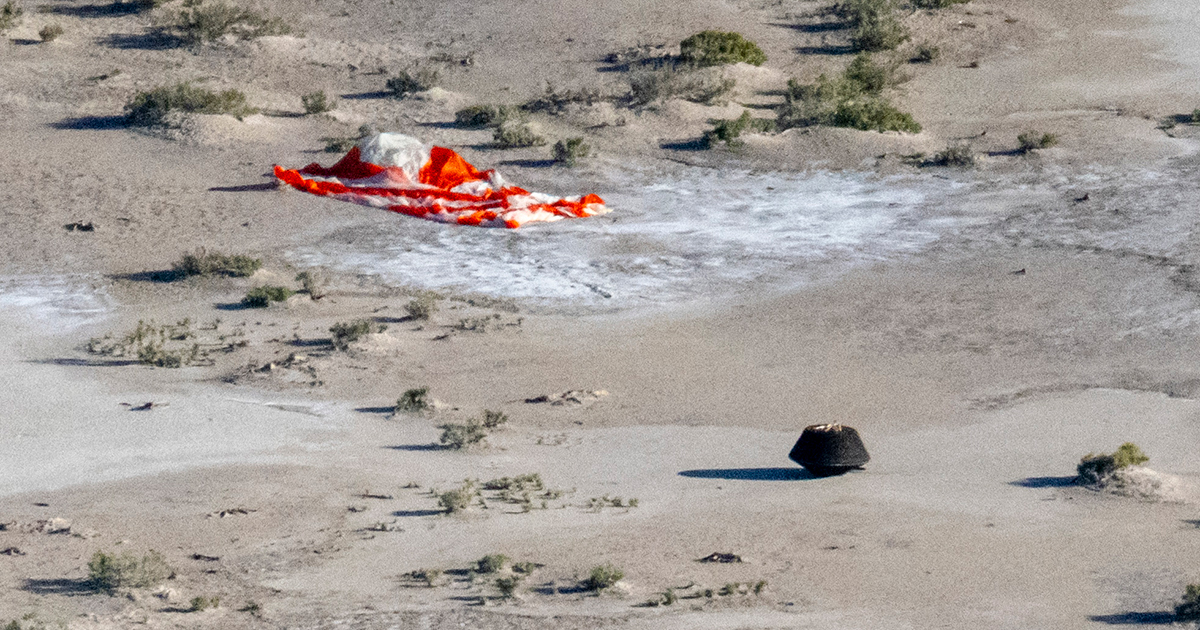NASA’s OSIRIS-REx spacecraft successfully brings back samples of asteroid Bennu to Earth
On September 24, 2023, history was made as the first U.S. mission to sample an asteroid successfully landed back on Earth. NASA’s OSIRIS-REx sample return capsule (SRC) touched down within the Department of Defense’s Utah Test and Training Range, bringing with it a half a pound (8.8 ounces or 250 grams) of rocks and soil from the asteroid Bennu.
The landing, which occurred at 8:52 a.m. MDT, marked the end of a seven-year journey that involved two years of mapping the carbonaceous space rock. The size of the asteroid, about the same as New York City’s Empire State Building, added to the complexity of the mission. Dante Lauretta, principal investigator for the OSIRIS-REx mission at the University of Arizona, described the asteroid’s shape as intriguing, resembling a droplet made of rock, gravel, and boulders held together by microgravity.
Despite the challenges posed by Bennu’s fluid-like behavior, it actually worked in favor of the mission. The probe’s “touch-and-go” mechanism was able to collect four times more asteroid material than initially anticipated, ensuring the success of the mission. The samples were delivered to Earth when the OSIRIS-REx spacecraft released the return capsule at 63,000 miles above the planet, starting its extended mission to study the asteroid Apophis after its close encounter with Earth in 2029.
The sample return capsule entered Earth’s atmosphere at a speed of 27,650 miles per hour, deploying a drogue chute two minutes later. Eventually, the main parachute deployed at around 20,000 feet above the Utah desert, slowing the capsule’s descent to just 11 mph. The entire descent took approximately 10 minutes, slightly faster than expected.
Once on the ground, NASA and Lockheed Martin personnel arrived at the touchdown site to retrieve the capsule. After ensuring its safety, the capsule spent its first night back on Earth in a temporary clean room at the Utah Test and Training Range. On the following day, it was flown by a C-17 military transport plane to NASA’s Johnson Space Center in Houston.
At the Astromaterials Laboratory in NASA’s Johnson Space Center, a new permanent clean room has been built to study the samples. The capsule and its contents will undergo meticulous examination by a team of scientists, and preliminary findings will be presented at a press conference scheduled for October 11.
The significance of this mission cannot be overstated. OSIRIS-REx is the first U.S. spacecraft and the third in the world to return asteroid samples to Earth, following Japan’s Hayabusa and Hayabusa 2 missions. Not only did it bring back the largest sample of asteroid material, but it also marks the largest extraterrestrial sample delivery since the Apollo missions that brought moon rocks and lunar soil back to Earth.
The analysis of these samples from Bennu holds immense scientific value. Scientists hope to gain insights into the formation and evolution of our solar system, as well as the origin of life on Earth. The study of these pristine materials will provide valuable information about the composition of asteroids and their potential resources.
The successful return of the OSIRIS-REx mission is a testament to human ingenuity and our ability to explore and understand the cosmos. As we continue to push the boundaries of space exploration, we are one step closer to unraveling the mysteries of our universe and our place within it.
